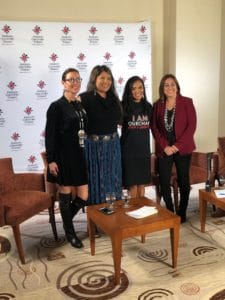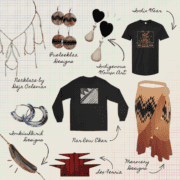
The Next Ten Years
How the 2020 Census Impacts Indian Country
By Jeanne Ferris

Left to right–Jessica Imotichey, Jourdan Bennett-Begaye, Lycia Maddocks, Kayla Olvera Hilario
Photo credit: Jeanne Ferris
Every ten years, the US Census Bureau (CB) counts people as required by the constitution since 1790. The significance of detailed enumeration is based on actual counts of persons dwelling in US residential structures. They include citizens, non-citizen legal residents, non-citizen long-term visitors and undocumented immigrants. Even newborn babies born on Census day, which is on April 1, 2020, are counted. No fooling.
April 2nd babies get counted in 2030.
So—why should you care?
In the beginning…
American Indians were not included in the general population unless they had given up their tribal citizenship and were assimilated into society. Reservation tribal members were considered “non-taxpaying” therefore disqualified to participate. By 1860, Indians were included in the count under the “color” column as “non-white” and not by tribal affiliation. Originally, Census takers were non-Native people defining Native Americans.
Despite inclusion, the 2010 Census Bureau reported that American Indians and Alaska Natives on reservations were undercounted by 4.9%. More than double the African Americans at 2.1%, the next most undercounted group by ethnicity.
This year, tribal leaders and CB are focusing on hard-to-count communities and hope that improved technology will produce a more accurate count. For example: in January, while the ground was still frozen, CB counters (of tribal affiliations) traveled by snowmobile, sled or bush plane deep into the Alaskan Native interior.
There is an amazing outreach of 16 partnerships on a national scale collaborating with the Native community. California has made an unprecedented effort to count tribes by informing and assisting all 110 Federally Recognized tribes to participate with the U.S. Bureau of Census. Census outreach activities have been allocated $3.12 million to fund Native Youth Engagement Initiatives, Native Census Event Scholarships, and Native Census Resources. Toolkits and funds are available to all California tribes.
Not even the pandemic COVID-19 could cancel the California Census Roundtable scheduled on March 9, 2020 at the Pala Casino Spa and Resort in California. With full attendance from media outlets and Census officials
—the commitment to broadcast critical Census information for dissemination to tribal nations was of equal importance.
The live stream broadcast was available on Rez Radio 91.3, Facebook Live, Vimeo and IndianCountryToday.com.
Based out of San Bernardino, First Nations Experience (FNX) is devoted to Native American and World Indigenous Content. FNX was present to record the broadcast and interview roundtable participants. This was the first live-streamed televised discussion of Native American specialists regarding the Census and tribal stakes in the Census by using information and communication technology (ICT) and FNX.
Today’s broadcast addressed Census tribal concerns. The discussion opened with a welcome from Chairman Robert H. Smith of Pala Band of Mission Indians and was followed by a message of urgency for full 2020 Census participation needed from Julie Lamb, regional director, California Census.
Mark Trahant (Shoshone Bannock Tribe) editor, Indian Country Today served as moderator for the discussion. Panel participants included:
- Jessica Imotichey (Chickasaw Nation), partnership coordinator, US Bureau of Census.
- Lycia Maddocks (Quechan), vice president of External Affairs, National Congress of American Indians.
- Jourdan Bennett-Begaye (Diné), Washington editor, Indian Country Today.
- Kayla Olvera Hilario (Ione Band of Miwok Indians), tribal affairs specialist, California Complete Count-Census 2020. Appointed by Governor Gavin Newsom.
Trahant’s opening statement was evocative, “Judge Diane Humetewa (Hopi) is the first and only active Native American woman to serve on the Federal Bench out of 875 federal judgeship—judges who often weigh in on tribal law and send many of our young people to prison.” This example of a lack of diversity is less than one-quarter of one percent of the federal bench and a bleak picture of fair representation for the American Indian population.
“This is our very first time in a decade to be visible. We weren’t counted in the first six census’, we’ve been invisible for so long,” Maddocks said. “There has been a historic undercount for Natives. The decisions that we make today will last for ten years. We have to participate—and it’s part of our treaty that the tribes are resourced appropriately.”
“We need to let our communities know that there are strict laws on confidentiality. There has been such distrust with the federal government in the past that when they knock on the door, the instinct is to hide your kids! The feds are here,” Hilario said. “This is not the case; we need to count the kids. There is a huge mistrust [with bureaucracy]. All your information is confidential. None of the data is shared with other agencies. You are safe.”
Imotichey’s one “takeaway” in the importance of the Census, “It’s easy. We like to say it’s 10 questions, 10 minutes, 10 years. So data matters. This is an exercise in sovereignty and there is a lot at stake for tribes. The census is about representation. It’s safe and we have best practices regarding tribal data.”
“There are six tribal affiliation questions added to the questionnaire for the first time,” Maddocks added. “These questions are not about self-enrollment, it’s about self-identification which is also important for the Urban Indians [off reservation]. Who do you identify with? This is important in a lot of mixed race families. If you identify with six tribes, there is room to write it in.”
Because the results of the Census affect school and education resources, social welfare benefits, parks, hospitals, medical services, housing vouchers, and other programs, these funds can impact your child’s growth. Children not included in this count will have to wait another ten years and these next ten years are important formative years. Parents and legal guardians need to include children and infants when participating in the Census.
It was estimated that approximately one million children were not included in the 2010 Census. This means that federal funding was short changed for child welfare, education resources, and public services such as Women, Infants, and Children Program (WIC). WIC provides direct monetary assistance for low-income pregnant women and new mothers with children.
Today’s growing children are our future policy makers and can eventually influence decisions made by the government. In addition, an undercount of every person living in the US affects long-term consequences on fair political representation and determines how many seats in Congress each state gets.
All CB employees take an oath of nondisclosure and are sworn for life to protect all information that could identify individuals. Any employee who violates the provisions of the oath is subject to a fine up to $250,000 or a prison sentence up to 5 years, or both. Under Title 13 of the US Federal Code, no employee or secretary of the bureau may use census data for anything other than its statistical purposes.
To paraphrase: by law, the Census Bureau cannot share respondent’s answers with anyone—not the IRS, not the FBI, not the CIA, and not with any other government agency such as ICE. With the influx of many undocumented immigrants occurring, there is a valid concern in privacy of personal information.
For the first time, Census forms are available online www.census.gov.
beginning March 12, 2020. All tribal inquiries regarding the U.S. Bureau Census questionnaire can be accessed on www.nativepeoplecountCA/org. or call (916) 365-5790. Respondents can still answer Census questions by telephone or by mail. ~ ~ ~



